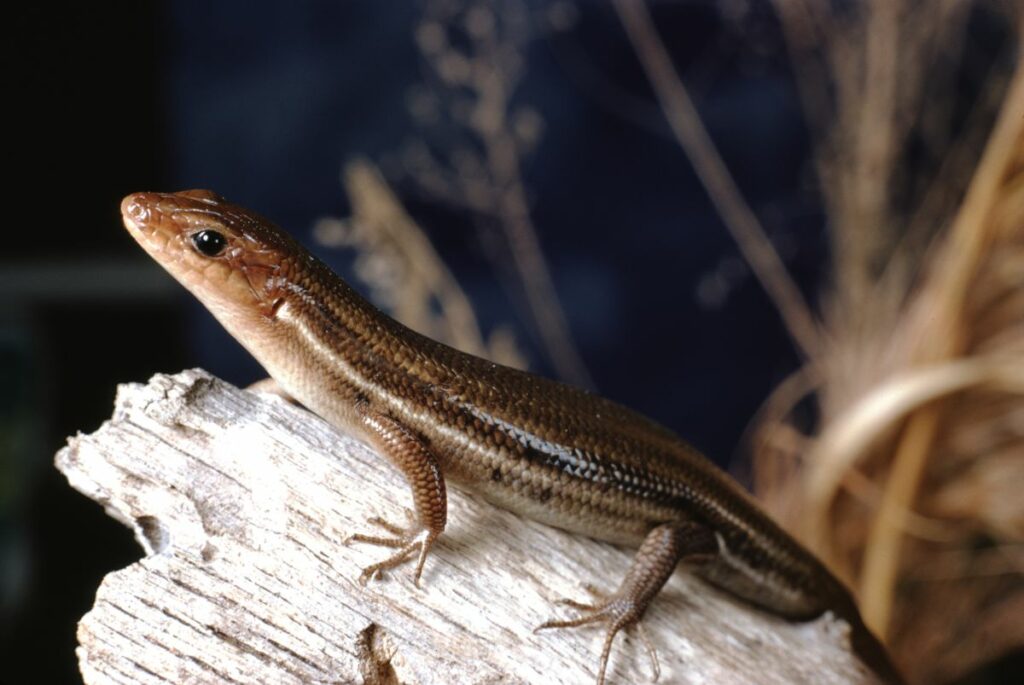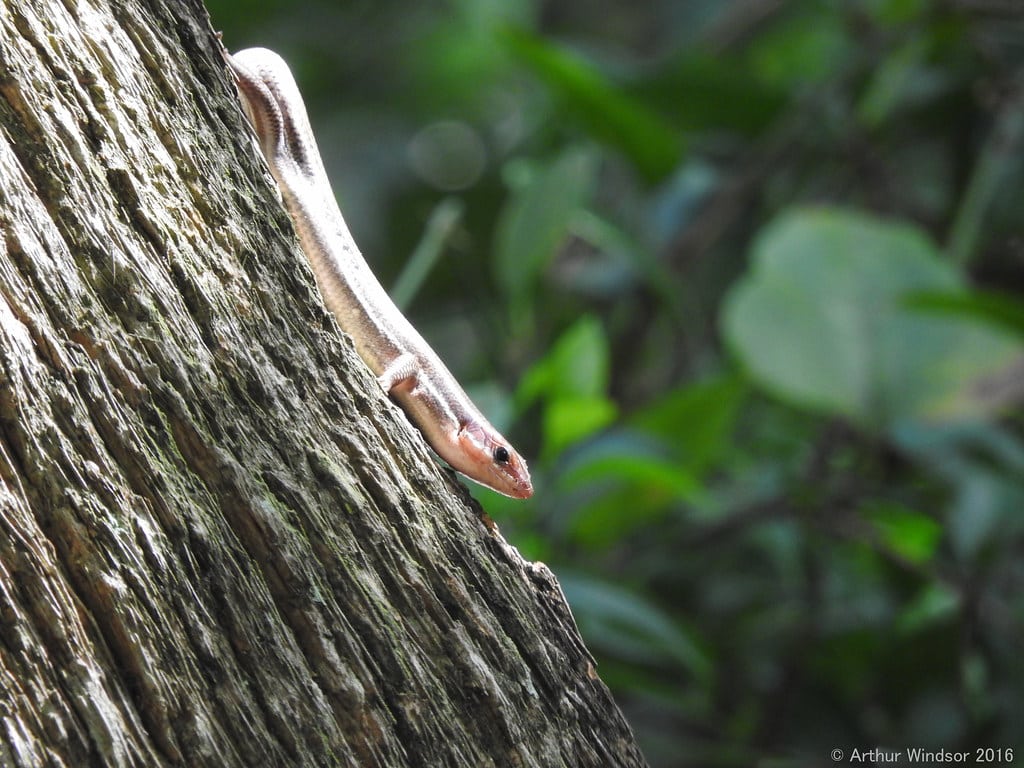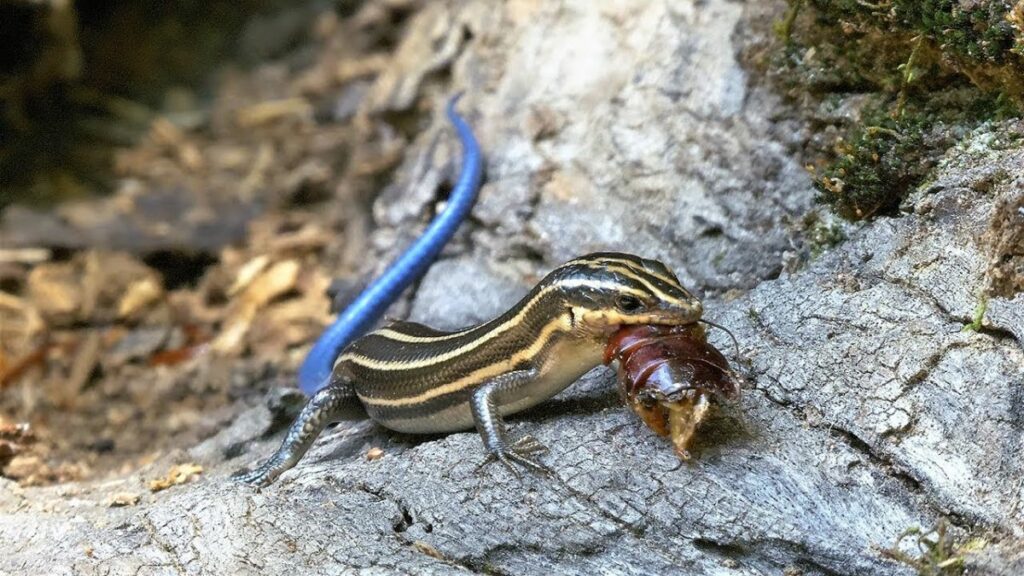The southeastern five-lined skink is often mistaken for the American five-lined skink or the broadhead skink.

These skinks are ground-dwelling reptiles who prefer drier climates and hiding under rocks. They are fast runners, so people rarely see them.
They are often mistaken as venomous because of their bright blue tail. But, southeastern five-lined skinks are completely harmless and actually make good pets.
What Is The Southeastern Five-Lined Skink?
The Southeastern five-lined skink is also a blue-tail skink. Their skin is smooth besides the row of small scales on the center of their body.
As with all skinks, they have streamlined bodies that are thicker at the core and tapers off toward the tail. Their legs are short compared to the rest of the body.
Young skinks are the ones with the vibrant blue tail that we associate with these lizards. Young skinks also have five whitish-yellow lines. Two lines run down either side of their body and the fifth goes down the center of their back. The rest of their body is dark brown to near black.
An adult skink is not as colorful as juveniles. As they age, the lines become darker and dull. Their bright blue tail also pales to gray.
People sometimes confuse these blue-tailed lizards for the American five-lined skink (plestiodon fasciatus) or the broadhead skink (Plestiodon laticeps). Southeastern five-lined skinks are identifiable upon inspection because they lack the row of enlarged scales under the tail that the other two species possess.
Five-Lined Skink Male VS Female
It’s simple to tell males and females apart once they are adults.
A female blue-lined skink generally maintains some of the striping. The dark band along the side of the body stays clearly visible.
Males lose most, if not all, of their striping. They may keep a hint of their stripes, but their body usually turns uniformly brown.
It’s even easier to tell the two apart during mating season. The head and jaw of a male will turn a bright reddish-orange.
- Common Names: Southeastern Five-Lined Skink
- Scientific Name: Eumeces [Plestiodon] inexpectatus
- Origin: Southeastern United States — some isolated populations as far north as New England & Ontario
- Skink Size (Length): 5-8.5 in (12.7-21.6 cm)
- Lifespan: Up to 6 years
- Enclosure Size: 20+ gallons or 18x24x48 in (45.7x61x121.9 cm)
- Temperament: Shy & peaceful
- Ease of Care: Moderate
Five-Lined Skink Habitat

Mostly, these skinks live throughout the southern United States, such as North and South Carolina, Tennessee, and Georgia. There are a few isolated populations as far north as New England and Ontario, Canada.
Southeastern five-lined skinks prefer areas with lots of rocks to hide in, and they live in areas of higher elevation. They are common near steep, open ledges with lots of shrubs and trees. Besides rocks, they seek rotten logs to hide in. These habitats are often close to deciduous forest habitats.
The southeastern five-lined skink seems to prefer drier habitats than other similar species.
In some parts of their range, they are common in sandy, coastal environments. In North Carolina, they even live on small islands where there is little vegetation and they have no access to fresh water.
Behavior & Temperament
The blue-tailed skink loves to bask in the sun when it’s not hiding under rocks. They are mostly ground-dwelling animals, skittering quickly across logs and rocks. You may occasionally see them climbing trees to look for insects.
When these lizards feel threatened, their first instinct is to run and hide. If caught, they have ways of escaping. A skink’s tail can detach when the animal is distressed to distract the attacker while the lizard escapes.
The Connecticut Department of Energy and Environmental Protection describes the ordeal like this:
“There are cleavage points along the tail vertebrae that facilitate the breakage, much like perforations on a piece of paper that make tearing the paper easier. The detached tail thrashes on the ground to distract the predator, generally allowing the lizard to escape. The five-lined skink will grow a new tail that is somewhat shorter than the original and somewhat gray in coloration”.
Losing its tail is not fatal and is a common defense mechanism among lizards. Upon loss of the tail, the skinks barely bleed, and their new tail grows back without bones. The South Carolina Department of Natural Resources describes how the new tail grows back:
“Excessive bleeding is prevented by sphincter muscles in the tail stump that constrict the caudal artery…The lost tail is then slowly regenerated. However, the new tail differs from the original in that it has a cartilaginous rod for support instead of vertebrae, its scales are of different size and shape, and its musculature and color are different.”
Diet

Five-lined skinks are carnivorous scavengers who prey on insects like crickets, grasshoppers, beetles, grubs, ants, and flies. They also feed on spiders.
Reproduction
In the northern parts of their range, like New England, the blue-tail lizard mates in April and May. The female will lay her eggs in June or July, about six weeks after mating.
She chooses an area under leaf litter, soft soil, or rotting bark to create her nest. Once the nest is complete, she will lay 4-20 eggs, with the average being 9-12 eggs. Female skinks that live at higher altitudes lay smaller clutches.
Mothers are fiercely protective of their eggs and will guard the nest while they incubate. Incubation lasts for about a month before hatching in August or September. The mother continues to guard her young for a day or two after hatching. Then, she leaves them to fend for themselves.
Mating and hatching likely occurs slightly earlier in the more southern regions.
Conclusion
The blue-tailed lizard, the southeastern five-lined skink, is sometimes mistaken for the American five-lined skink and the broadhead skink. It is slightly bigger than the American five-lined skink, and it is less arboreal than the broadhead skink.
Speedy and elusive, it is difficult to glimpse these lizards. Still, you may see the bright blue tail of the juveniles darting between rocks and shrubs.
Peaceful, they even make wonderful animals for those who prefer hands-off pets.
FAQs
Many people in the southern United States believe skinks are poisonous. The misconception likely comes from the skink’s bright colors that people normally associate with poisonous or venomous animals.
Despite the misconceptions, no skink in existence is poisonous or venomous. Rather, they are completely harmless to humans.
The southeastern five-lined skink lives as far north as New England across parts of Connecticut and Vermont. There are a few separate populations that live in parts of Iowa, western Wisconsin, Minnesota, and even Ontario, Canada.
As these areas get harsh winters with frigid temperatures, the skinks need to adapt. They begin hibernation in October and shelter until mid-March. They hide under large rocks, decaying logs, and even underground.
When hibernating, southeastern five-lined skinks may remain alone, or join a small group of the same species.
The southeastern five-lined skink was last assessed in 2007 by the International Union for the Conservation of Nature (IUCN). The IUCN lists the southeastern five-lined skink as “least concern” with stable populations.
To date, the species doesn’t face any major threats. They are hardy, and capable of adapting to moderate habitat changes like some forest clearing and logging. If an area experiences a lot of fires and burning, the species does not adapt well.
Like the American five-lined skink (Eumeces [Plestiodon] fasciatus), the Southeastern five-lined skink makes a good pet. Skinks are hardy, good-natured animals that are easy to care for. (I included a link to my American five-lined skink article here. You can swap it out for the website link once you post the article.)
These skinks are shy and don’t like to be handled. They are best suited for people who prefer a hands-off pet.
